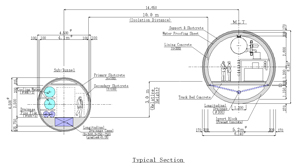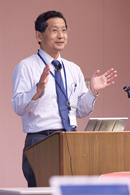 |
 |
|||||||||||||
|
|||||||||||||
|
|||||||||||||
|
On 1-2 June, the review on the design study of the ILC conventional facility in mountain regions was held at KEK, Japan, and the final review report was submitted last week by the review panel lead by Vic Kuchler of Fermilab to Seiya Yamaguchi, head of KEK's Linear Collider Office and to Marc Ross, project manager of the Global Design Effort (GDE) in charge of the conventional facility study (GDE/CFS). Refining the design presented in the Reference Design Report (RDR) in 2007 to better optimise the performance to cost, and to risk is one of the GDE's main objectives during the Technical Design Phases (TDP-1: 2008-2010 and TDP-2: 2010-2012). One of the most complex and difficult changes under consideration is changing a double-tunnel design to a single-tunnel configuration. The Asian team consists of scientists and engineers at KEK and Japan's leading civil-engineering specialists had provided the single-tunnel conceptual design of the ILC conventional facility (CF) in mountain regions, and published the report in March this year. The panel reviewed the report and checked the consistency of the design with the GDE/CFS design guideline. They also went over reviewing the work-package plan for conventional facility design to be carried out in the Japanese fiscal year 2010. Since about 70 percent of land in Japan is mountainous, Japanese sample sites naturally sit in places from hillside to mountain area. Constructing the tunnels and caverns in such areas would bring certain technical challenges to consider. The review report states: “It was clear to the panel that work produced by the KEK LC-CFS [linear collider-conventional facility study] Group in conjunction with the AAA (Advanced Accelerator association for promoting science and technology) CE-WG [Civil Engineering Working Group] represented a good deal of practical experience with the construction of underground enclosures in these mountainous conditions. The information provided in the various talks presented a good description of the status of the work completed to date.” Many construction cases were presented to the panel, and one of those cases, the construction of the Hida tunnel, was somehow shocking to them. The Hida tunnel is the second longest highway tunnel in Japan, stretching 10.7 kilometres, piercing the Momi-nuka Mountain 1744 metres above sea level. In Japanese, Momi means "rice husks" and Nuka means "rice bran": The mountain is said to be named after the characteristics of very fragile and unstable soil. “It was one of the toughest construction cases ever experienced in Japan,” said Masanobu Miyahara, CFS specialist at KEK's Linear Collider Office, who made a presentation at the review. The tunnel was constructed as an expressway tunnel to connect villages otherwise isolated, so there was no space left for route choice. There was massive earth pressure due to more than 1000 metres of earth load on top, plus awful spring water up to 70 tonnes per minute, and hostile geological conditions which changed as the tunnel boring machine advanced. “I hesitated to present the Hida tunnel case, since it may have sent an inadequate message that all Japanese constructions would be as difficult as this one. But I decided to show it to the panel because we learnt so many lessons from this experience that will be helpful to the ILC tunneling,” said Miyahara. One of the lessons reflected into the conceptual design was the use of a smaller pilot tunnel in conjunction with the main single tunnel for the accelerator. Boring multi-purpose pilot tunnels is an established exercise in Japan. The tunnel helps to understand and to better prepare for geology ahead of the main tunnel. It is also used for ground-water drainage and dewatering of the rock mass around the main tunnel, space for utility distribution, or as an alternative exit way out from the main tunnel. The pilot-tunnel approach raised discussions, and the panel pointed out the interest to further study this approach, for example in terms of understanding the minimum lead time for effective use of the gained information, or cost to advantage analysis of the pilot tunnel. The panel concluded: “It is very apparent that the conceptual design work being done by the KEK Linear Collider-Conventional Facilities and Siting Group in conjunction with the Advanced Accelerator Association is detailed and effective. The combination of these two groups has had a very positive influence on the Asian Regional CF effort and on the GDE CF effort in general. The design work described in the various presentations seems to be fully consistent with the design guidelines for SB2009/TDP-2. Although there is still much work to be done, the outline for the planned work through 2012 seems to compliment the work that has already been completed.”
“I would like to thank all who realised this very successful review: the review panel members, the presenters and especially the efforts made by the AAA and the Japan Society of Civil engineering,” said Akira Yamamoto of KEK/ILC-GDE who acted as the review Secretary. “With the help of this report, KEK can carry forward a more in-depth detailed technological study on the Asian CFS design effort.” The full review report is available here. -- Rika Takahashi |
|||||||||||||
| © International Linear Collider |

